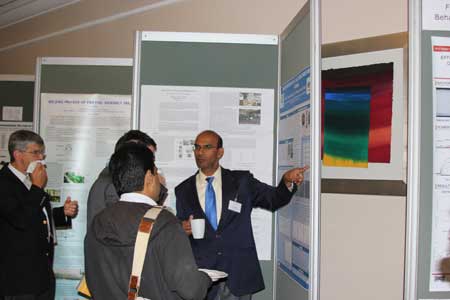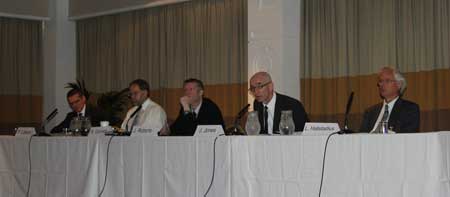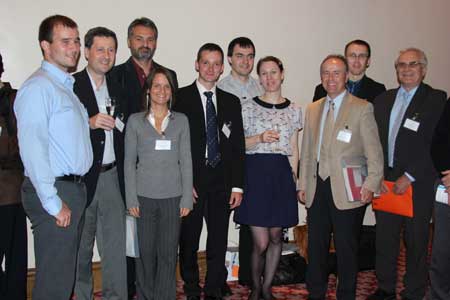

TopFuel 2012 – a personal perspective
After three years absence the TopFuel conference once again returned to Europe, more specifically to Manchester, UK . It took place from 2 to 6 September at the Renaissance Manchester Hotel, right in the heart of the city, which provided an amazing backdrop to the conference.
Top Fuel 2012 was organised by the European Nuclear Society (www.euronuclear.org) in cooperation with the American Nuclear Society and the Atomic Energy Society of Japan. TopFuel’s primary objective is to bring together leading specialists in the field of nuclear fuel management from around the world to analyse the advances that have been made in nuclear fuel management technology and to use the findings of cutting-edge research to help manufacture the high performance nuclear fuels of today and tomorrow. And, from a personal perspective, I can say that it succeeded. Many specialists gathered in Manchester and shared their knowledge and experineces. It was good opportunity for me as a student and a young specialist in the field of nuclear fuel to learn and take part. Nothing can beat gaining experience like this.
The conference was divided to the two parts: three days were reserved for the conference proceedings itslef and one day for the technical visits. Some delegates visited the Westinghouse Springfields site and others visited the Dalton Nuclear Institute, at the University of Manchester. The conference itself was divided into six sessions, supported by a poster exhibition. The six sessions were as follows: Plenary Session, Operation and Experience, Transient Fuel Behaviour, Design and Materials, Modelling and Spent Fuel and Transportation. Some sessions took place in parallel. There were a total of 113 oral presentations given and 47 posters exhibited. All the papers that were presented are available online on the TopFuel 2012 website at:
(www.euronuclear.org/events/topfuel/topfuel2012/transactions.htm).

The conference started officially on Monday 3 September with a welcome address by Mark Basset and a keynote address by Victor Inozemtsev. The speeches focused mainly on the global situation and what is needed to ensure the future sustainability of nuclear energy in the energy market.
Over the course of the three days many issues about nuclear fuel were discussed. Most presentations were focused on light water reactor (LWR) fuels, but advanced fuels were disussed too, for example a fuel with silicon carbide cladding. Among the frequently mentioned topics at the conference were high burn-up, MOX fuel, fission gas release, post-irradiation examination, fuel failures during operation (such as oxidation and the corrosion of Zr alloys), hydridation, cracking, the influence of different additives on the properties of fuel cladding, transient behaviour of fuel and computational codes and modelling. From my point of view, there were a lot of highly specialised presentations and projects relevant to delegates’ work, whatever their field of interest. Many delegates discussed their work experiences, addressed key issues and expressed their particular perspectives. For me the gratest asset of TopFuel 2012 was the opportunity it offered me to present my work, to discuss it with my peers - and analyse their work too. It enabled me to gain new insight into certain problems and to see what is new in my field of interest. TopFuel 2012 met all my requirements.

Another essential part of conference is the social programme, which allows participants to make new contacts and to finish off the discussions that they weren’t able to complete during the conference sessions or coffee breaks. The social programme began with the eve-of-conference welcome drink, on Sunday 2 September, which concided with the conference pre-registration. On Tuesday 4 September, we participated the TopFuel 2012 Conference Dinner, at Manchester Town Hall. Manchester Town Hall is one of the most iconic landmarks in the city. It is situated on Albert Square and was completed in 1877. I have to say that the Town Hall is an amazing and wonderful place and I really enjoyed being there. First we enjoyed a glass of sparkling wine in The Bees room. The bee is one af symbols of Manchester. Bees are known as hard workers with a vital role to play in the ecosystem. That is why the bee symbolises Manchester’s industry; it was adopted during the Industrial Revolution, in which Manchester played a leading role. After drinking and discussing we relocated to the Great Hall. The hall´s ornate ceiling illustrates the principal countries and towns with which Manchester has traded in the past. Another thing that is really interesting to see is the magnificent organ, which has over 5,000 pipes and is almost five metres tall.
During the excellent three-course dinner, which was served with Italian wine, we were surprised by opera singers dressed as waiters. Suddenly, one waiter started singing Italian opera arias with a glass of wine in his hand. After few minutes all three waiters were singing. It was breathtaking because the singing was supported by the Great Hall’s excellent acoustics.
After dinner and the brief opera performance we danced to the sound of modern music or discussed fuel issues with our peers. During such events many people share their knowledge and experiences. They provide an excellent opportunity for young people like me to mix and network with other experts and to share common interests.
On Wednesday 5 September, the Farewell Drink provided an appropriate conclusion to conference, before the technical visits kicked off the following day. I was one of the group that visited Springfields. After one and half hour in the bus and checking in at reception, we were given a great presentation outlining the history of the site, the products and services that it provides for its customers, and how Springfields fits into Westinghouse’s global business activity. The site has been in opration since 1946 and has been producing fuel for more than 50 years. Now the fuel production is focused on AGR and PWR reactors. In the UK there are one Magnox NPP (Wylfa 1), six AGR NPPs (Dungeness B 1&2, Hartlepool 1&2, Heysham I-1 & I-2, Heysham II-1 & II-2, Hinkley Point B 1&2, Hunterston B 1&2, and Torness 1&2) and one PWR (Sizewell B).
After the presentation we were devided into two groups. The first one had lunch, while the second one visited the Oxide Fuel Complex. Then the groups changed round. We were able to see how AGR fuel is made. It is amazing how different the fuel is when compared with LWR fuel.
And how do they make the AGR fuel? At first, it is necessary to change the UF4 to UF6. Then it is sent to be enriched to about 3 % of 235U. After the UF6 is enriched, it is converted to UO2 powder in a kiln. Then the UO2 powder is processed, it is pressed, heated in a furnace and grinded to produce the fuel pellets. The fuel pellets are stacked inside a stainless steel tube (the fuel cladding) that is one meter long. After the tubes are sealed and pressurised with helium, they are put together in the graphite sleeve to form the AGR fuel assembly. Each fuel assembly contains 36 fuel pins (tubes) and each fuel pin contains 64 pellets. After the fuel assembly is inspected to check the quality of the fuel, it is packed and ready to use in an AGR reactor. The AGR core is higher than the LWR, it contains seven or eight fuel assemblies asembled vertically, so it is about eight metres high.
The procedure for LWR fuel fabrication is different. Initially, LWR fuel pellets undergo the same manufacturing process as AGR fuel pellets. After fabrication, however, the fuel pellets are loaded inside zirconium alloy tubes, which are about three metres long. Then they are pressurised with helium, sealed and fitted inside a pre-assembled framework. They are also inspected before being used in the reactor. The LWR core 50% shorter than the AGR core. Moreover, the LWR fuel rod contains not only the pellets but also the plenum springs. These pellets are put in the cladding tube, they are not stacked inside a fuel rod, like the AGR pellets.

I would like to thank the ENS staff (especially Emilia Janisz and Kirsten Epskamp) for its organisation of this great conference and for the very friendly atmosphere. Personally, as the Czech Young Generation reporter I am also grateful for the financial support that I was given by the IAEA and by my employer, the Research Centre Rez.
Martina Malá
Research Centre Rez
Reactor Services Division
Technological Circuit Innovation Department
Czech Republic
mlm@cvrez.cz
|

